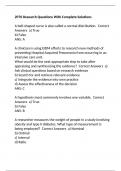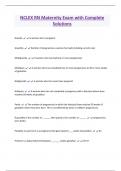Spreitzer (2017): Alternative Work Arrangements: Two Images of the New World of Work
Alternative work arrangements capture everything from high-skilled freelancers to low-wage service
workers who are on a call for unpredictable work to work from anywhere
2 trends:
I. gig work (platform connects workers directly with customers for the gig, link to the client is
short)
II. virtual: full-time employees telecommuting
3 forces fueling the growth of alternative work
I. Changing macroeconomic environment
● Workforce on demand / open talent economy: firms seek flexibility through employment at will
(in the US)
● The shareholder replaced the stakeholder model because it benefits investors → less likely to hire
standard employees.
● Implications: less upward mobility, less institutional protection, a decline in union membership,
precarious work, power differentials between employees and employers are amplified
II. Innovations in technology
● Cloud technology (people can work from anywhere and access whatever)
● Collaborative softwares (teamwork enabled from anywhere)
● Knowledge sharing tools
● Technology disaggregated to the task level', making it easier to open the tasks
● Online talent platforms
III. Preferences of workers in this economy
● More people are choosing self-employment for freedom, flexibility but also (20%) for the
inability to find a job.
● Dual career families? Need for flexibility
Classification
In the past, this classification could be applied (Pfeffer & Baron, 1988)
A. part-time workers (temporary attachment)
B. teleworkers (limited physical attachment)
C. independent contractors (limited administrative attachment)
Alternative classification (Capeeli & Keller, 2013)
A. employment (direct control over a worker's actions)
B. contract work (worker has control over their actions)
!!neglects other important dimensions relating to alternative work arrangements, namely
flexibility about the location and timing of work!!
For this reason, three dimension of flexiblity under alternative alternative work work arrangements
identified
I. Flexibility in the employment relationship
3 categories in Cappeli & Keller (2013)
A. Direct employmebt byond the standard employment relationship
● direct employment = employment relationship between the employer and employee. Largest type
is full-time employment
○ Part-time employment: thesame as full time but less career advancement. Hired because :
, a) retaining high-performance works who prefer to work less by negotiating
idiosyncratic work arrangements. Also called retention part-timers for their
commitment. Higher performance evaluations compared to full-timers
b) scheduling flexibility to reduce wage/benefits costs → bad outcomes for those
who do this because they cannot find a job
B. Co-employment/agency work
● 3 parties: client organization, staffing agency and the worker
● Leased workers (long term contractors) vs short-term contractors
● Choice of agency as a result of being laid off, flexibility, try-out before full-time employment
● Challenges: little probability of moving into full-time employment
C. Contracting
● Hired to apply skills/knowledte to a specific short temr project, all specified in a contract
● High skilled = freelefreelencers, low skilled = day laborors who negotiate on the spot (no job
security)
II. Flexibility in the scheduling of work
● Gig = very flexible, agency = assinged schedule
● Dual families → need for flexible work, negotiated through I-deals
● Negatives: stigma, tool for marginalization, need to be always online/available, women not
working long hours don't get promotions
● Positives: choosing when/where towroking → positive for family, reduced turnover
III. Flexibility in the location of where work is acoomplished
● Positives in standard jobs: virtual work reduces stress, increases orgnaizational commitment, job
satisfaction, job performance, reduce in commuting times, saves real estate costs, and makes
demographic characteristics less salient
● Negatives: lonely, less engaged, less knowledge sharing → technology can help
○ fewer opportunities for development and promotion, weakened relationships with
coworkers, increase work-family conflict, blurring boundaries
● Moderators: having a choice, scheduling flexibility to work remotely, good relationships with
bosses/coworkers, working vitrually in moderation
● Different timzeones? Negative influence coz of fewer opportunities to interact face to face,
electronic dependence, splitting groups into subgroups
Creating a more positive new world work
1. Economic security → invest in a good job strategy. Individuals: have skills that are in demand
2. Purposeful work → encourage employees to create meaningful work through work titles,
Individuals: create a stronger working environment through connections
3. Supportive work arrangements → personalise functional working spaces
,Parker and Grote (2022): Automation, Algorithms, and Beyond: Why Work Design Matters More
Than Ever in a Digital World
Introduction: proposes a central role of work design in understanding the effects of digital technologies
Positives of technology
● Digital goods/services are cheaper → no need for localised expensive production
● Replacement of hierarchies with flexible network structures
● More permeable boundaries across organizations
Negatives: erosion of the need for human workers → AI will take over 47 % of jobs
This article says: insufficient attention is given to technology and the changes
Aim of this article: understand how work design can be affected y new technologies and suggest how to
minimize the risk and maximize the opportunities
Is this time any different?
Fourth industrial revolution: the core role of AI and in particular, machine learning, which involves a shift
of agency from humans to technology as technology becomes capable of self-directed learning.
Ubiquitous Computing: how computer sensors and other devices are linked to objects, people, the
physical environment, information, and other devices, with the aim that technologies “weave themselves
into the fabric of everyday life until they are indistinguishable from it”
● hyperconnected and data-saturated world, liked to big data = basis for self-learning systems
, ● new business models (Uber, AirBnb) offering services based on decentralized coordination
between supply and demand
What is different? Combination of big data and AI enabling substitute humans in cognitive and
higher-skill domains
Future? replacement of human judgement, AI can learn on their own from the environment
Central role for work design
● human work is crucial → tasks will be automated, not whole jobs
● work design is the heart of understaning/shaping new technologies
○ the same technology can have a different impact on the human and the job depending on
the work design
How can technology affect work design? (extensive table with details in the article)
→ Autonomy
3 perspectives on autonomy:
I. Stress perspective: autonomy helps with actively managing demands in the environment
II. Hackman and Oldman: enhances meaning and motivation and reduces turnover and absenteeism
III. Sociotechnical systems perspective: high autonomy supports efficient decision-making because
decisions about managing variances and disturbances in work processes are made locally rather
than having to spend time by being referred to higher levels of autonomy
2 types of autonomy based on what i relates to:
I. The work itself: decision-making over work process (decision-making autonomny), the
opportunity to choose timing of work tasks (timing autonomy) and being able to choose work
➕
methods (method autonomy) → Decision-making autonomy
technology enables decetnralized decision making → greater job autonomy; enables agility →
increase job autonomy and employee satisfaction; broader distribution of knowledge →
➖
self-organizing, grass-roots communities
technology can interfere with human autonomy → automation results in giving people the
leftover tasks = human are supervisory controllers. Out of the loop perfromance = operators of
automated machines, compared to manual operators, become increasingly unable to detect system
errors and perform manual tasks in the face of automation failures due to the loss of manual skills
and loss of situational awareness of the system
→ Timing autonomy
→ Method autonomy
II. Influences about where and when one works: flexible working = boundary control ICT results in
more autonomy over when and where people work, but it can also bring deman for constant
connectivity
→ Skill variety and use
➕
● well-design jobs have a skill variety and use
technology takes over dull tasks and individuals can engage in skilled and meaningful tasks
➖
→ upskilling
technology can reduce skill variety and used as standardized and the process can reduce task
variety (in lean production)
→ Job feedback and related work characteristics



